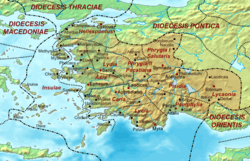Satala in Lydia

Satala (Σαδαλείς) in Lydia was a Roman era city[1][2] and Bishopric[3]
Location
The city is tentitivily located at Sandal, Manisa Province in Western Turkey.[4] It is mentioned in Acta Sanctorum and possibly claudius Ptolemy, and Anton Itinery.[5] and is shown on Peutinger Table.[6]
Pagan Religion
The city worshiped the typical mother and son pantheon found throughout Anatolia, and although a temple was built it did not mint coint as the town was only a village. It was part of a decapolis called the Katakekaumene, and May have been its religious center.
Bishopric
The city was also a see in the province of Lydia, and remains a vacant and titular see to this day.[7] It is in the province of Sardis.
Known Bishops
- Andrew[8](Council of Chalcedon)
- Elpidius of Satala banished after the Council of Constantinople[9][10]
- Giuliano signed in 458 the letter of the bishops of Lydia to ' Emperor Leo I after the death of Proterius of Alexandria.
- Michael attended the Second Council of Nicaea (787) .
- Philip took part in the Council of Constantinople (879)
Today Satala Lidia survives as titular bishop of the Roman Catholic Church but the seat is vacant since 22 October 1819 .
See also
References
- ↑ W. M. Ramsay, The Historical Geography of Asia Minor.(Cambridge University Press, 2010) p131.
- ↑ Joseph Bingham, The Antiquities of the Christian Church, 2 Volumes (1848)p400.
- ↑ Satala at Catholic eirachy.org.
- ↑ Sandal Konisi. Kula.
- ↑ W. M. Ramsay, The Historical Geography of Asia Minor.(Cambridge University Press, 2010) p71.
- ↑ John Anthony Cramer, A Geographical and Historical Description of Asia Minor;: With a Map, Volume 2(At the University Press, 1832) p 152-160.
- ↑ http://www.catholic-hierarchy.org/diocese/d2s34.html
- ↑ Richard Price, Michael Gaddis, The Acts of the Council of Chalcedon, Volume 1 (Liverpool University Press, 2005) p91.
- ↑ Philostorgius, in Photius, Epitome of the Ecclesiastical History of Philostorgius, book 5, chapter 1.
- ↑ Socrates of Constantinople, Church History, book 2, chapter 42.
- ↑ Beschreibung auf catholic-hierarchy.org (englisch)
- ↑ Apostolische Nachfolge – Titularsitze
- ↑ Eintrag auf gcatholic.org